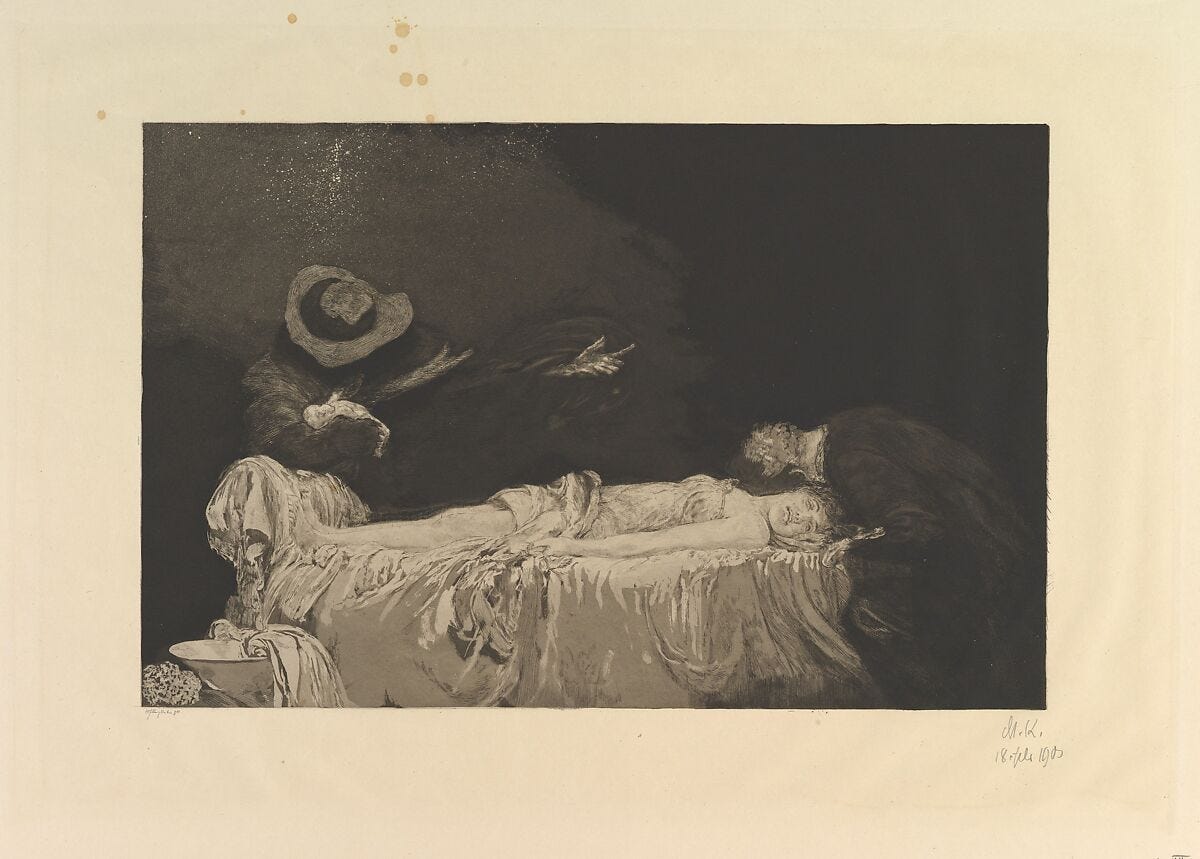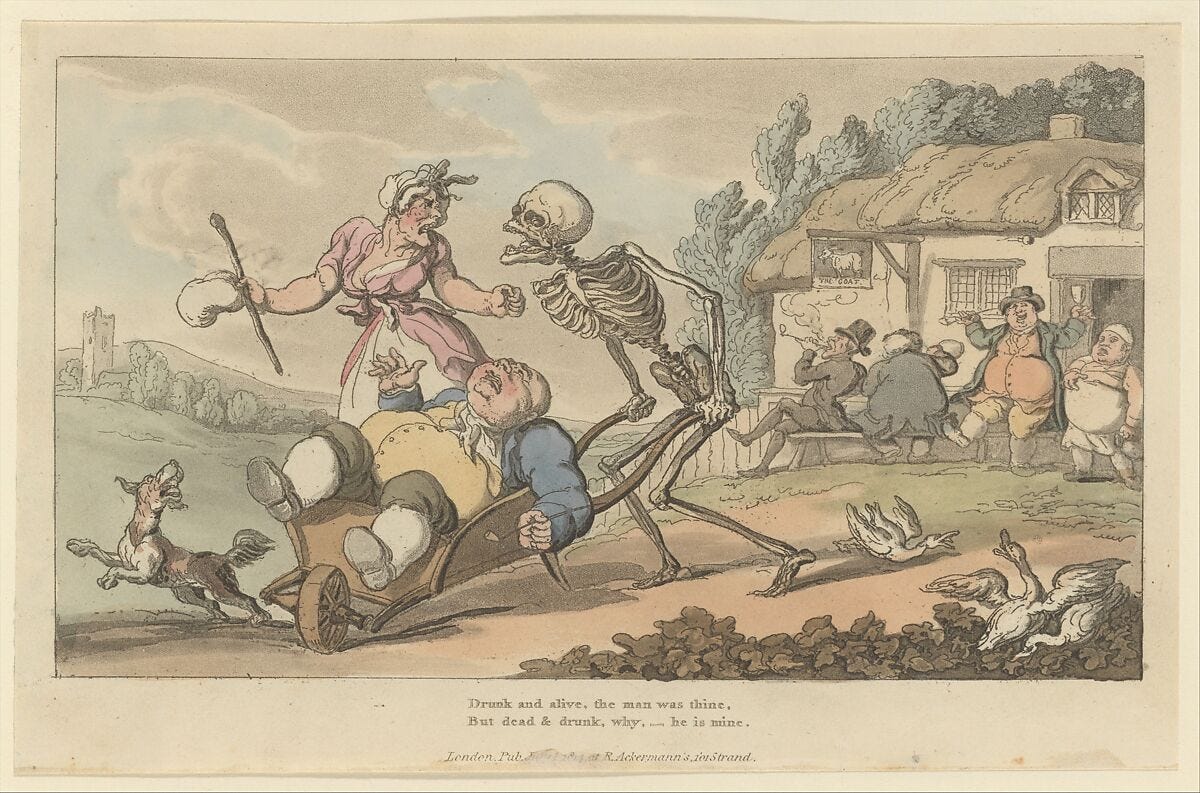Bad news for my haters, good news for my fans, neutral news for people who are ambivalent about me: I’ve made a Substack! While this will primarily be used to talk about my upcoming solo journaling TTRPG, Sin-Eater, it will almost certainly eventually expand into hyperspecific, rambling posts about stuff like the legal distinction between flotsam and jetsam, the fact that humans form butthole-first in utero, and other pieces of hard-hitting journalism.
Anyway!
First thing’s first, what is sin-eating? Considering how metal it is, there’s surprisingly little known about it. Ignoring for a minute the clear implication here that I think metalness should be the driving factor behind which cultural practices do and do not get preserved, let’s talk about the allegedly real history of this job.
Pictured: Death comes for us all in the end and he’s being really weird about it.
Author’s note: Despite my best efforts to do independent, verifiable research, most of what’s publicly available regarding sin-eating boils down to the same 4-5 facts regurgitated across a handful of blogs and YouTube videos. I’ve done my best to confirm everything below; if you have a little knowledge about sin-eaters and you notice anything missing, it’s because I wasn’t able to verify it outside of the aforementioned blogs and videos, which all just link back and forth to each other in sort of a Hapsburgian sourcing structure that proved about as effective as you’d expect. My primary sources for the following are the writings of Welsh historian Mike Dash, whose blog is incredible and worth a deep dive.
Broadly, a sin-eater’s job was to absorb the unresolved transgressions of a person who had died without their last rites. Within Catholicism, an individual can receive a deathbed sacrament that tidies up any lingering sin they may not have been able to confess prior to their looming expiration. Catholic last rites cannot be performed after a person has died, which is an inconvenience to anyone who believes in everlasting damnation for those with tarnished souls. This is where the sin-eater comes in. An expendable soul, summoned by the family of the dead to take the sins of the deceased upon themselves. The process by which this was done seems to have varied slightly based on rare surviving accounts of the practice, but generally, a sin-eater’s job was to consume food and drink that had been laid on the body as a conduit for sin transference. This food usually took the shape of a crust of bread or unleavened cake and a small amount of ale or milk that was eaten near the corpse. Some reports mention that the process was accompanied by ritual singing or prayer, but what these rites may have been has been lost to history.
Pictured: My cats waking me up in the morning.
Sin-eating as a practice is primarily associated with the UK, and, more specifically, Wales and the Welsh marches (the transitional counties that form the border between Wales and England). While the idea of sin transference or post-mortem absolution isn’t confined only to these regions, it’s these practices that served as the primary inspiration for Sin-Eater. The earliest surviving written record of it appears to be “Remaines of Gentilisme and Judaisme, 1686-87” by John Aubrey, which was written in the 17th century and published in 1881. Based on how Aubrey references sin-eating as an archaic custom in his book, it seems that it was already a dying practice by the time of his writing. As for when sin-eating began, that’s equally shrouded in mystery, although Dash notes that it is most likely tied to the Old Testament concept of a scapegoat: quite literally, a goat that was prayed over to take on the sins of man, and then left to wander the wilderness and do whatever it is that goats do when left to their own devices.
As with most low-prestige jobs, a major reason why so little is known about sin-eating is because it was considered a shameful and repulsive practice (Aubrey described one sin-eater as a “...long, lean, ugly, lamentable Raskel” which, like most historical dunks, goes hard as hell). Outside of one fairly notable exception which we’ll get into in a future post, sin-eaters were generally incredibly poor, forced into the position of taking on countless sins for the wealthy dead for nothing more than some table scraps and a shilling for payment. Once the ritual was complete, the sin-eater beat a quick retreat to the relief of the family that enlisted their services, as it was believed that sin-eaters were detestable creatures, likely on account of the fact they were just stuffed to the gills with sin. A bunch of lamentable Raskels, if you will.
Pictured: The true lamentable Raskels of this story.
The last thing I’ll say is that while Sin-Eater is inspired by this seemingly real historical practice, you’ll see that it’s hardly a 1:1 recreation. Being able to choose sin-specific foods, decide whether your sin-eater is revered or reviled, and just broadly worldbuild without these historical constraints helps keep the game from being boring as shit. Hopefully!
If you want to learn more about sin-eating, I recommend checking out these extremely well-researched Reddit comments from the aforementioned Welsh historian Mike Dash. While I recognize that citing Reddit comments is antithetical to ethical blogging, he does a phenomenal job citing his sources and distilling down a ton of interesting information about sin-eating. His most recent findings seem to suggest that our modern understanding of sin-eating is likely a misinterpretation of modified post-Reformation Catholic funerary practice, but a definitive history of sin-eating still remains elusive.
What were 'Sin-Eaters'? And when did the tradition die out? [links to relevant comment]
What gave rise to the practice of sin-eater (or the myth about it)? And why it occured on England and Wales in 17th century specifically? [links to relevant comment]






